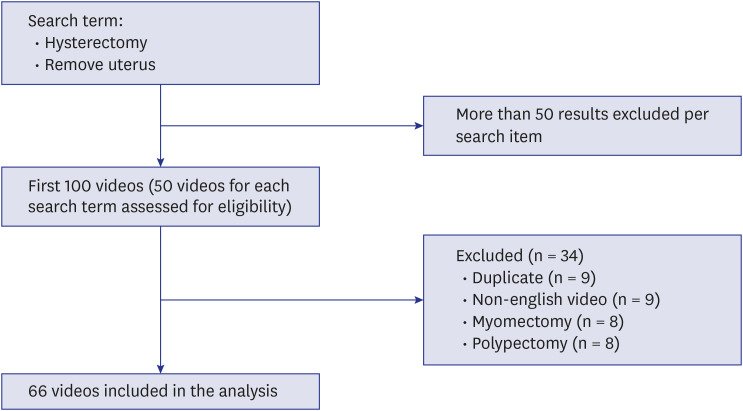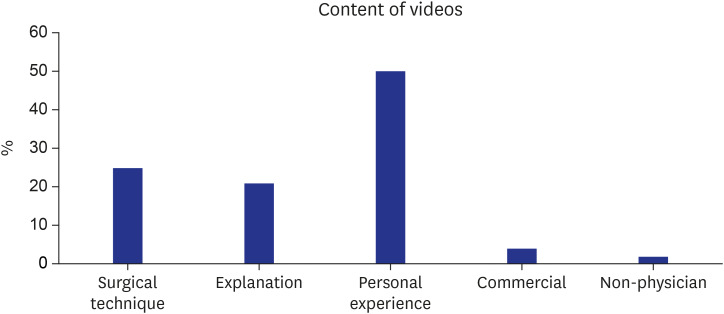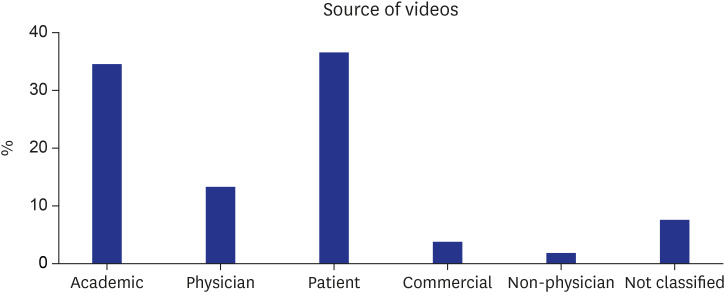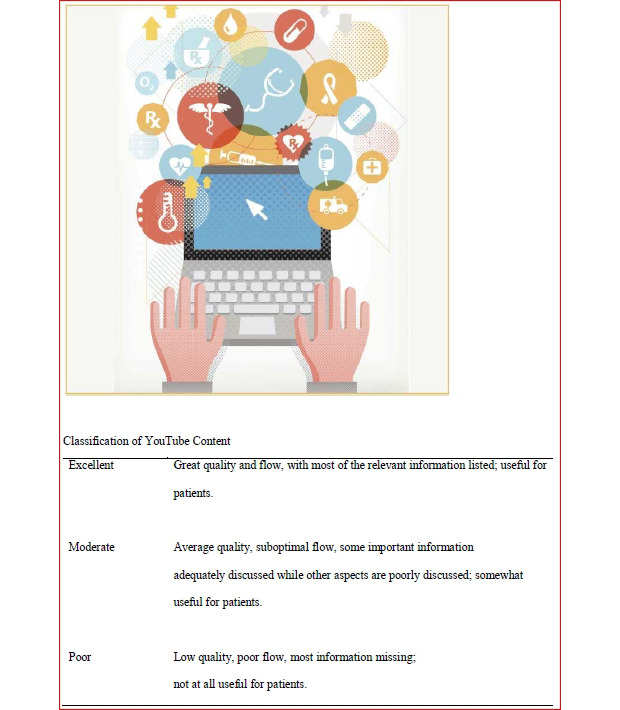This article has been
cited by other articles in ScienceCentral.
Abstract
Background
Globally, YouTube is one of the most popular websites, and the content is not restricted to entertainment. The purpose of this study was to assess the quality of information in YouTube videos pertaining to hysterectomy.
Methods
We explored YouTube using the search terms “hysterectomy” and “remove uterus.” The videos that appeared were sorted using the filter “sort by view count.” Of the initial 100 videos, the top 50 videos for each search term were included for review, as determined by the “relevance” filter based on YouTube's algorithm. After excluding 34 videos for various reasons, 66 were included in the final analysis. Each video rated as “useful” was further analyzed for reliability and completeness of information; a set of pre-determined criteria were modified from a previous study and used to grade the quality of videos.
Results
The top 66 videos on hysterectomy had a total of 4,679,118 views. Based on authorship, the videos were categorized as follows: videos uploaded by patients, 37%; academic videos, 35%; videos uploaded by physicians, 13%; commercial videos, 4%; and videos uploaded by non-physicians, 2%. The type of content was also categorized: 50% of the videos recorded personal experiences, 23% recorded surgical techniques, 21% involved explanations of the surgery, and 4% were commercial videos. The majority of the videos made by patients were negatively biased toward hysterectomy surgery (71.72%), while the majority of those made by academics or physicians were surgical educational videos for doctors, not patients.
Conclusion
YouTube is currently not an appropriate source for patients to gain information on hysterectomy. Physicians should be aware of the limitations and provide up-to-date and peer-reviewed content on the website.
Go to :

Graphical Abstract
Go to :

Keywords: Hysterectomy, YouTube, Internet, Quality of Information
INTRODUCTION
Widespread internet use has resulted in easy access to online resources, which serve as an influential source of health information for patients.
1 Patients and caregivers are particularly likely to seek health information online.
2345 Recent surveys have found that 8 of 10 internet users have accessed health information online.
67 Among online resources, YouTube is one of the most popular websites, with over 1 billion users watching over 1 billion hours of video each day.
8 There is also a high level of information posted by experts. However, because YouTube does not question the credibility of video creators, information that is not appropriate (or lacks expertise) is often posted. As with many websites, the content on YouTube is not peer reviewed; therefore, registered users can, essentially, post any content they choose. As more medical professionals recognize the importance of YouTube as a source of medical information for the general public, the number of studies evaluating the quality of information found on YouTube is increasing. In this scenario, healthcare providers and government agencies are expressing reservations about the accuracy and quality of information currently available, particularly because of anecdotal reporting and personal opinions.
91011
Hysterectomy is the most frequently performed gynecological procedure for the treatment of benign or malignant uterine disease. Overall, 1 in 9 women in the United States will undergo the procedure during her lifetime.
1213 The most common indications for hysterectomy (some of which overlap) are symptomatic uterine leiomyomas (51.4%), abnormal uterine bleeding (41.7%), endometriosis (30%), and prolapse (18.2%).
13 With technological advances, the proportion of minimal invasive surgery (laparoscopic or robotic surgery), which reduces discomfort, risk of infection, and recovery time, is increasing in comparison to that of vaginal or abdominal hysterectomy. However, there are no published studies analyzing the information about hysterectomy available on YouTube.
The primary purpose of this study was to understand the way in which videos available on YouTube portray hysterectomy; the secondary purpose was to analyze the content of viewer comments related to hysterectomy.
Go to :

METHODS
Search strategy
The YouTube search was conducted on May 1, 2019 using the terms “hysterectomy” and “remove uterus.” The inclusion criteria for videos were that they: 1) were in English, 2) contained primary content related to hysterectomy, and 3) had acceptable audiovisual quality. The exclusion criteria were: 1) languages other than English, 2) absence of audio or visual stimuli, 3) satirical videos, and 4) duplicate videos.
A new account was created to avoid YouTube's viewing history-based video suggestions. The videos were sorted using the option “sort by view count.” Of the 100 initial videos, the top 50 videos for each search term were included for review, as determined by the “relevance” filter, according to YouTube's algorithm. A total of 34 videos were excluded (duplicate videos, 9; non-English videos, 9; myomectomy, 8; polypectomy, 8). Ultimately, 66 YouTube videos found using the keywords “hysterectomy” and “remove uterus” were included (
Fig. 1).
 | Fig. 1Methodology of selection of YouTube videos for analysis.
|
Video assessment
For each video, the following general parameters were recorded: 1) number of views, 2) duration (seconds), 3) total number of “likes” and “dislikes,” as depicted by the “thumbs up” and “thumbs down” icons, and 4) type of content. By primary intention, videos were categorized into 4 groups: 1) concerning surgical technique, 2) providing information about the disease or surgery, 3) relating a personal experience, and 4) advertisement (
Fig. 2). By authorship, videos were categorized into 6 basic groups: 1) academic (author/s was/were affiliated with a university), 2) physician (author/s who was/were not affiliated with a university), 3) patient, 4) commercial, 5) non-physician (allied health professional/therapist, physiotherapist, or dietician), and 6) unclassified (
Fig. 3).
 | Fig. 2Categorization by content.
|
 | Fig. 3Categorization by sources.
|
All videos rated as “useful” were further analyzed for reliability and completeness of information; 2 of the authors modified a set of pre-determined criteria from a previous study and used them to grade the quality of videos (
Table 1).
14 Videos rated as “excellent” have great video quality, accuracy of information, and coherence and are also useful for patients by way of presenting information regarding pre- and post-surgical processes as well as postoperative care. Videos rated as “moderate” convey information that is of average quality and possesses suboptimal flow; some important information is adequately discussed, but there is information that is poorly discussed and overall, the video is only somewhat useful for patients. A “poor” video has a low quality of information and flow, and is not at all useful for patients.
Table 1
Classification of content

|
Quality grade |
Description |
|
Excellent |
Great quality and flow, with most of the relevant information listed; useful for patients. |
|
Moderate |
Average quality, suboptimal flow, some important information adequately discussed while other aspects are poorly discussed; somewhat useful for patients. |
|
Poor |
Low quality, poor flow, most information missing; not at all useful for patients. |

Statistical analysis
The data were independently collected by 2 gynecologists with expertise in hysterectomy (open, vaginal, laparoscopic, robotic) using a Microsoft Excel spreadsheet. Statistical analysis was performed with SPSS Statistics Version 21.0 (IBM Co., Armonk, NY, USA). Descriptive statistics were generated for video characteristics including source, intention, and number of views since posting. The mean and range of the data were calculated for continuous variables, and frequencies and percentages for categorical variables. The degree of agreement between the 2 reviewers was assessed using Cohen's Kappa coefficient: the interpretation based on established criteria suggested that values in excess of 0.8 represent “excellent” agreement, between 0.6 and 0.8 represent “substantial” agreement, between 0.4 and 0.6 represent “moderate” agreement, and lower than 0.4 represent “poor” agreement.
15
Ethics statement
Institutional Review Board approval was unnecessary for this study, because only public access data were used.
Go to :

RESULTS
The top 66 videos on the subject of hysterectomy had a total of 4,679,118 views with a mean of 91,747 (standard deviation [SD], 191,428) and range between 3,211 and 1,237,943. The videos had a mean duration of 783 (SD, 717) seconds with a range of 138 to 3,297 seconds. The mean number of thumbs ups for each video was 441.3 (SD, 659.1) while the mean number of thumbs downs was 43.6 (SD, 112.1). The most viewed video had 1,237,943 views and was produced by a hospital; it used animation to explain hysterectomy. This video also had the maximum thumbs downs (776). The video that received the maximum thumbs ups (3,100) featured a woman describing her treatment experience.
The categorized sources and primary intention of the videos are shown in
Fig. 1. It was observed that 37% of all the videos were uploaded by patients, 35% by academics, 13% by physicians, 4% by commercial sources, and 2% by non-physicians. The other 8% remained unclassified. Regarding primary intention, 50% of the videos recorded personal experiences; 23% recorded surgical techniques including open, vaginal, laparoscopic, and robotic; 21% involved explanations of the surgery or treatment; and 4% were commercial videos.
In general, the information content in the majority of the videos was low, with only 6% classified as “excellent,” while 43% were “moderate” and 51% “poor.” One of the videos that was rated “excellent” had the largest number of views (1,237,943) and also, ironically, the maximum thumbs downs. The video that received the maximum thumbs ups—3,100—was rated “poor” and produced by a patient. The inter-observer agreement for bias assessment was substantial.
The majority of the videos created by patients were negatively biased toward hysterectomy surgery (71.72%). Further, the majority of the videos created by academics or physicians were educational in nature, concerning surgical techniques and targeted at doctors, not patients.
Go to :

DISCUSSION
This study determined that the quality and reliability of hysterectomy-related information offered on YouTube is low. YouTube is the most popular online video-sharing platform and the second most accessed page on the web. Google web searches also direct users to YouTube content.
16 YouTube does not have any strict regulations, and requires no formal identification to upload and publish videos. For these reasons, anyone—experts, companies, and laypeople—can publish content. YouTube also allows the publisher to classify the content into different categories including education and science, with no pre-determined peer review guidelines.
There were several videos describing patients' feelings after the surgery, with most of the information being related to sex. Videos based on personal experience have the disadvantage of providing potentially inaccurate information. Patients mentioned only their own discomfort, largely related to sex, and many videos comprised negative views about the surgery. Typically, patient-created videos gave the impression that medical staff's explanations regarding the surgical pain or sexual intercourse-related changes to expect had been insufficient. Investigating topics that are commonly explored in YouTube videos or, conversely, those that are ignored, may assist physicians in counseling their patients. In this regard, physicians also have to pay close attention to the individual concerns of patients, such as those related to pain after sex, hormonal changes in the menstrual cycle, or menopause. While some educational videos mention the postoperative situation, this aspect is not well covered; further, it is necessary to make objective and subjective videos about patients' questions. In order to ensure the provision of accurate information, it is necessary to make efforts to produce factually accurate educational videos that include the procedure as well as pre- and postoperative management.
Hysterectomy videos can be categorized into a separate group where only medical personnel, such as medical students, surgical interns, residents, and surgeons seeking to learn the procedure, are allowed to post videos. Many of the videos depicted laparoscopic or robotic surgery, probably because shooting these surgeries was easy. Many videos describing surgical techniques did not offer nuanced details. It is also necessary to produce surgical training videos according to standard surgical guidelines. These must showcase the procedure, as performed by skilled professionals, and include the whole process, starting from preparing the patient for surgery.
Orthopedic and general surgeons have been known to seek information from YouTube videos, inevitably coming across poor-quality information. In this context, to present an overview of the improvement measures listed in other papers, Singh et al.
11 mentioned that to improve the usability of online healthcare information, physicians must emphasize the need for patients to be selective when accessing medical information from the web. Physicians could provide patients with basic guidelines for content evaluation, such as how to assess sponsorship and disclosures as well as factual information, based on the Medical Library Association's “User's Guide to Finding and Evaluating Health Information on the Web.” As per Lee et al.,
17 there are many YouTube videos demonstrating laparoscopic cholecystectomy with wide variations in video quality; videos uploaded by tertiary centers showed the highest educational value. The discrepancy in video quality is generally not recognized by viewers. Thus, there is a need for more high-quality videos, and YouTube must implement an active filtering process. Reflecting this and applying it to this paper, relatively experienced doctors are capable, to some extent, of evaluating the usefulness of information available on YouTube by making a comparison with information from other sources. However, as all doctors may not successfully manage this, it is imperative that published videos contain accurate information.
As discussed before, there has been a surge in articles evaluating YouTube videos. A recent systematic review concluded that YouTube holds a vast amount of data regarding healthcare, some of it incorrect or misleading.
1718 However, a standard method of analysis of this content has not yet been established. While there have been efforts to establish guidelines for analyzing the content of YouTube videos, they have had limited results.
19 A standard guideline is necessary for any future research. As mentioned in a paper about human papillomavirus, while people often seek objective information, they tend to accept only the information that is in consonance with what they want to establish.
20 In addition, a peer review of these issues may be necessary because people tend to believe information obtained through the internet more than that provided by actual doctors.
A limitation of our study was that it analyzed only 66 YouTube videos identified by the use of the keywords “hysterectomy” and “remove uterus.” However, studies have shown that most people do not peruse more than 1 or 2 pages of search results.
21 In other words, instead of accessing all the available information, people review only the information they encounter first. Our study included and evaluated the first 50 videos for each search term because the primary goal was to evaluate the information quality of videos viewed by non-medical professionals. Another limitation was that we focused exclusively on YouTube and did not include medical websites, which may provide better-quality educational videos.
Considering the influence of the internet in general and YouTube in particular, it is important to attempt to satiate people's hunger for knowledge, rather than just delivering academic content at the society or group level. There is a need for specialization of content; for example, if the aim is to present a patient experience story, it is important to study patients in a specialized institution and then proceed to the interview format. If one is attempting to cater to both specialists and laypersons, there is a need to analyze where people's curiosity stems from, as well as the available media, to determine how to proceed. In other words, to meet the needs of the general public, it is up to specialists to work together to create high-quality, accessible content. In order to transfer objective and scientific knowledge, it will be necessary to create a task force team that monitors YouTube content at the societal level and create video productions of patients' questions or monitor them through quality assurance of the videos that have been produced.
Our study contributes to a better understanding of the available information about hysterectomy, which is widely viewed on YouTube. The results suggest that the quality of information in videos on hysterectomy is poor, and YouTube is not currently an appropriate source of such information for patients. The medical community can improve online patient education by focusing on the topics discussed in these videos. Physicians should be aware of the limitations of YouTube and provide up-to-date and peer-reviewed content.
Go to :



